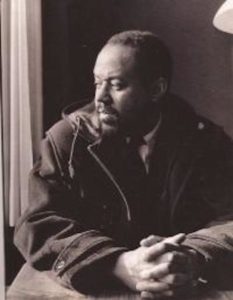
Walter H. Williams
*Walter H. Williams was born on this date in 1920. He was a Black artist, painter, printmaker, and sculptor.
Walter Henry Williams Jr. was born in Brooklyn, New York. His mother, a compassionate artist, died from pneumonia when Williams was five. His strict, authoritative father then took custody of him and his younger sister. Due to the death of his mother and a non-nurturing father, he became withdrawn from others, preferring to live in his dream world. He spent much of his youth in Harlem attending "jukebox joints, the local pool halls, and the few nightclubs that catered to a Black clientele." There, he met many artists from various fields.
With their influence and his "early artistic talent," he became a painter. Williams was drafted into the army from 1942 to 1945. His assignment was to an all-Black unit in France. His job was to dig soldiers' graves. His son Darius reports that Walter witnessed the burial of an alive soldier. Grim and dreary, it "haunted him the rest of his life." Williams continued to be shy in adulthood and was described as "reserved."
He often suffered from depression and alcoholism and was given medication. In 1951, he enrolled at the Brooklyn Museum Art School under the G.I. Bill. Despite being a poor high school student, Williams was scholarly and paid close attention to his lessons. In the summer of 1953, he studied at the Skowhegan School of Painting and Sculpture in Maine under a scholarship. That same year, he participated in his first major group show, Whitney's 1953 Annual Exhibition of Contemporary American Painting.
He graduated in 1955. After graduating, Williams won the John Hay Whitney Foundation fellowship award, amounting to $2,400. His grandfather, from the Danish West Indies, spoke well of the country; thus, Williams used the money to travel to Denmark. The direction of his art changed significantly; it previously reflected isolation in the city and, now, the beauty of the countryside. Bornholm, a small Danish island with "fantastic nature," awestruck Williams, influenced this change. Williams also spent four years in Mexico from 1959 to 1963. His work was shown in various exhibitions, such as the Instituto Nacional de Bellas Artes in Mexico City.
He traveled back and forth to the United States. He explained to a Mexican reporter that he felt that by living in a racially liberal Mexico, "the freedom from racial prejudice was essential" for his personal and artistic development. In 1963, he returned to the United States only for a year due to the racial climate. In 1964, Williams won $1000 as a part of the Silvermine Guild Award for Oil Painting. He used this to finance a second trip to Denmark (specifically, Copenhagen). Shortly after his arrival, he organized an exhibition entitled "Ten American Negro Artists Living and Working in Europe." The other artists featured were Harvey Cropper, Beauford Delaney, Herbert Gentry, Arthur Hardie, Clifford Jackson, Sam Middleton, Earl Miller, Norma Morgan, and Larry Potter.
In 1965, Williams returned to New York as his woodcut, Girl with Butterflies #2, was purchased by the National Collection of Fine Arts of the Smithsonian Institution for the Executive Wing of the White House during the Lyndon B. Johnson administration. He attended a special reception in commemoration. In February 1966, his newer works were exhibited at the Noa Noa Gallery in Copenhagen, Denmark. Out of 19 paintings, 12 were sold and remain in Danish collections.
Williams had three children by two wives. His first two children, Ronald and Larry, were birthed by his wife, Shirley. Shirley did not approve of him becoming a painter because of the lack of security and stability, so Williams left her and his two children to pursue his passion. His second wife, Marlena, whom he met in Denmark at one of his exhibitions, birthed his last child, Darius. Born in 1973, he also became an artist, following in his father's footsteps.
The American racial climate didn't improve; Williams was often anxious and depressed due to discrimination against interracial marriage (his wife was Danish). After a year, Williams couldn't take it any longer and left the United States, never returning. Williams spent his final years in Copenhagen. In 1979, he had lived there for 14 years and became a Danish citizen. In 1980, his studio was destroyed by fire, losing all his paintings and prints. Depressed, he was unable to work for several months. In 1983, he stopped making art altogether, as he said everything he wanted with his art.
His health started to decline, and he began to withdraw from friends. His last exhibition was in 1985 at the International Art Fair in Tokyo, Japan, representing Denmark. His health worsened; Walter Williams died on June 13, 1998, due to liver cancer. He was 77 years old.